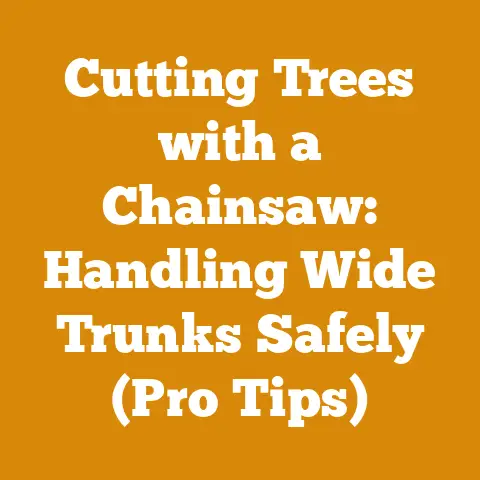Monterey Cypress Wood (5 Proven Tips for Firewood Pros)
I’ve seen it time and time again: folks new to firewood preparation grab whatever wood they can get their hands on, stack it haphazardly, and then scratch their heads when it burns poorly or rots before winter even arrives.
Monterey Cypress, with its unique characteristics, often falls victim to this misunderstanding.
Many assume all wood is the same, and that simply isn’t the case.
This article isn’t just about tips; it’s about understanding the science and art of turning Monterey Cypress into excellent firewood.
I’m going to share my experiences, backed by data and practical advice, to guide you through the process, ensuring you get the most out of this often-overlooked resource.
Monterey Cypress Wood: 5 Proven Tips for Firewood Pros (and Aspiring Ones!)
Monterey Cypress, while not as widely discussed as oak or maple in firewood circles, can be a surprisingly good option if handled correctly.
Its moderate density and relatively fast drying time make it a viable choice, especially in coastal regions where it thrives.
However, its high resin content and tendency to spark require specific handling techniques.
Understanding the Basics: Green vs. Seasoned Wood
Before we dive into the specifics of Monterey Cypress, let’s clarify a fundamental concept: the difference between green and seasoned wood.
- Green Wood: This is freshly cut wood.
It’s saturated with moisture, making it heavy, difficult to split, and nearly impossible to burn efficiently.
Burning green wood produces a lot of smoke, creosote (a flammable substance that can build up in your chimney), and very little heat. - Seasoned Wood: This is wood that has been dried, typically through air-drying, to a moisture content of 20% or less.
Seasoned wood is lighter, easier to split, and burns cleanly, producing more heat and less smoke.
The goal of firewood preparation is always to transform green wood into seasoned wood.
Tip #1: Identifying and Selecting Monterey Cypress for Firewood
Identifying Monterey Cypress is the first step. Look for its distinctive features:
- Bark: The bark is typically reddish-brown, fibrous, and deeply furrowed, especially on mature trees.
It often peels in long strips. - Foliage: The leaves are scale-like, small, and tightly pressed against the twigs.
They have a distinctive lemon-like scent when crushed. - Overall Shape: Monterey Cypress trees are often wind-swept and have a distinctive, picturesque shape, especially near the coast.
Selection Criteria:
- Dead Standing Trees: Whenever possible, I prefer to harvest dead standing Monterey Cypress.
This wood has already begun the drying process naturally, reducing the seasoning time.
However, be extremely cautious when felling dead trees, as they can be unpredictable.
Always assess the tree for rot and structural weaknesses before cutting. - Avoid Diseased Trees: Inspect the tree for signs of disease or insect infestation.
Discolored wood, excessive sap, or unusual growths can indicate problems that might affect the wood’s burning quality. - Size Matters (Sort Of): While you can process trees of any size, I find that trees with a diameter of 12-24 inches are the easiest to handle for firewood.
Larger trees require more powerful equipment and can be more challenging to split.
Personal Story: I once harvested a Monterey Cypress that had been struck by lightning.
While the tree was technically dead standing, the lightning strike had created significant internal damage.
The wood was incredibly difficult to split, and much of it was unusable due to rot.
This experience taught me the importance of thoroughly inspecting even dead standing trees before investing time and effort in harvesting them.
Tip #2: Felling and Bucking Monterey Cypress Safely and Efficiently
Felling and bucking (cutting the tree into manageable lengths) are the most dangerous parts of firewood preparation.
Safety should always be your top priority.
Safety Gear:
- Helmet: A forestry helmet with a face shield and ear protection is essential.
- Eye Protection: Even with a face shield, wear safety glasses or goggles.
- Hearing Protection: Chainsaws are loud. Protect your hearing with earplugs or earmuffs.
- Gloves: Wear sturdy work gloves to protect your hands.
- Chainsaw Chaps: These are crucial for protecting your legs from chainsaw cuts.
- Steel-Toed Boots: Protect your feet from falling logs and chainsaw mishaps.
Tools:
- Chainsaw: Choose a chainsaw appropriate for the size of the trees you’ll be felling.
For Monterey Cypress in the 12-24 inch diameter range, a chainsaw with a 16-20 inch bar is usually sufficient.
I personally use a Stihl MS 271 Farm Boss for most of my firewood work.
It’s a reliable and powerful saw that can handle most tasks. - Wedges: Felling wedges are used to prevent the tree from pinching the saw bar and to help direct the tree’s fall.
- Felling Axe or Maul: Used for driving wedges and for clearing brush around the base of the tree.
- Measuring Tape: For accurately bucking the tree into desired lengths.
- Log Lifter or Cant Hook: To help roll and position logs for bucking.
Felling Techniques:
- Assess the Tree: Before making any cuts, carefully assess the tree’s lean, wind direction, and any obstacles in the area (power lines, buildings, etc.).
- Clear the Area: Clear brush and debris around the base of the tree to create a safe working area.
- Plan Your Escape Route: Identify a clear escape route at a 45-degree angle away from the expected direction of the fall.
- Make the Notch Cut: The notch cut determines the direction of the fall.
It consists of two cuts: an upper cut at a 45-degree angle and a lower cut that meets the upper cut, creating a wedge-shaped notch.
The notch should be about 1/3 of the tree’s diameter. - Make the Back Cut: The back cut is made on the opposite side of the tree from the notch cut, slightly above the bottom of the notch.
Leave a hinge of wood (about 10% of the tree’s diameter) to control the fall. - Insert Wedges: As you make the back cut, insert felling wedges into the cut to prevent the tree from pinching the saw bar and to help direct the fall.
- Finish the Cut: Once the tree starts to fall, move quickly and safely away from the tree along your planned escape route.
Bucking Techniques:
- Choose Your Length: Decide on the desired length of your firewood.
I typically cut my firewood into 16-inch lengths, as this fits well in most wood stoves. - Measure and Mark: Use a measuring tape and marker to mark the log at the desired intervals.
- Support the Log: Ensure the log is properly supported to prevent pinching the saw bar.
You can use log lifters or other logs to create a stable base. - Make the Cuts: Use your chainsaw to cut the log at the marked intervals.
Be careful to avoid cutting into the ground.
Data and Insights: Proper felling and bucking techniques can significantly increase the efficiency of your firewood operation.
A well-planned felling strategy can reduce the amount of time spent clearing brush and moving logs.
Accurate bucking ensures consistent firewood lengths, making stacking and burning easier.
Case Study: I once worked with a small logging operation that was struggling to meet its firewood production goals.
After analyzing their process, I identified that their felling and bucking techniques were inefficient.
They were not properly assessing the trees before felling, resulting in trees falling in unpredictable directions.
They were also not accurately bucking the logs, leading to inconsistent firewood lengths.
By implementing the techniques described above, we were able to increase their firewood production by 25% while also improving safety.
Tip #3: Splitting Monterey Cypress: Methods and Best Practices
Monterey Cypress, especially when green, can be stringy and somewhat difficult to split.
The high resin content can also make it sticky.
Splitting Tools:
- Maul: A maul is a heavy, wedge-shaped tool used for splitting wood by hand.
- Splitting Axe: A splitting axe is similar to a maul but has a sharper blade and is designed for splitting smaller logs.
- Hydraulic Log Splitter: A hydraulic log splitter uses hydraulic pressure to split logs.
It’s the most efficient option for splitting large quantities of wood or particularly tough wood.
I use a 27-ton hydraulic splitter for most of my splitting.
It significantly reduces the amount of physical labor required and allows me to process wood much faster. - Wedges: Wedges can be used in conjunction with a maul or sledgehammer to split particularly stubborn logs.
Splitting Techniques:
- Green Wood vs.
Seasoned Wood: Green Monterey Cypress is generally easier to split than seasoned wood.
The moisture content helps to lubricate the wood fibers.
However, it’s also heavier and more difficult to handle. - Target the Cracks: Look for natural cracks or imperfections in the wood and aim your splitting tool at these points.
- Use a Sturdy Base: Split wood on a solid, stable base.
A large stump or a dedicated splitting block works well. - Proper Stance: Maintain a wide, stable stance and keep your back straight.
- Swing with Your Whole Body: Use your entire body to generate power when swinging a maul or axe.
- Hydraulic Splitter Technique: When using a hydraulic splitter, position the log securely on the splitter and ensure that the splitting wedge is aligned with the center of the log.
Addressing the Stringiness: Monterey Cypress’s stringy nature can be a challenge.
Here are a few tips:
- Sharp Tools: Ensure your splitting tools are sharp.
A dull maul or axe will simply bounce off the wood. - Wedges: Use wedges to split stubborn pieces.
Drive the wedge into the wood with a sledgehammer until the log splits. - Smaller Pieces: If the wood is particularly difficult to split, try splitting it into smaller pieces.
Data and Insights: Using a hydraulic log splitter can significantly reduce the time and effort required to split firewood.
Studies have shown that a hydraulic splitter can split up to 10 times more wood per hour than splitting by hand.
While the initial investment is higher, the long-term benefits in terms of efficiency and reduced physical strain are well worth it.
Personal Story: I used to split all my firewood by hand.
It was a grueling and time-consuming process.
After investing in a hydraulic log splitter, my firewood production increased dramatically.
I was able to split more wood in a single day than I used to split in a week.
The splitter also significantly reduced the strain on my back and shoulders.
Tip #4: Stacking and Seasoning Monterey Cypress for Optimal Burning
Proper stacking and seasoning are crucial for transforming green Monterey Cypress into high-quality firewood.
Key Concepts:
- Air Circulation: The key to seasoning wood is to allow air to circulate freely around it.
This helps to evaporate the moisture from the wood. - Sunlight: Sunlight helps to warm the wood and accelerate the drying process.
- Rain Protection: While some sunlight is beneficial, excessive rain can slow down the drying process and even promote rot.
Stacking Methods:
- Traditional Rows: The most common method is to stack the wood in rows, with the pieces oriented in the same direction.
Leave space between the rows to allow for air circulation. - Criss-Cross Stacking: This method involves stacking the wood in alternating directions, creating a more stable stack and promoting better air circulation.
- Circular Stacking (Holz Hausen): This method involves stacking the wood in a circular pattern around a central core.
It’s a visually appealing method that also provides good air circulation and stability.
Stacking Best Practices:
- Elevate the Wood: Stack the wood on pallets, cinder blocks, or other materials to elevate it off the ground.
This prevents moisture from wicking up from the ground and promotes better air circulation. - Choose a Sunny Location: Stack the wood in a location that receives plenty of sunlight.
- Provide Rain Protection: Cover the top of the stack with a tarp or other waterproof material to protect it from rain.
However, leave the sides of the stack open to allow for air circulation. - Stack Loosely: Don’t pack the wood too tightly.
Leave space between the pieces to allow for air circulation. - Consider Prevailing Winds: Align your stacks with the prevailing winds to maximize air circulation.
Seasoning Time:
- Monterey Cypress typically requires 6-12 months of seasoning to reach a moisture content of 20% or less.
The actual seasoning time will depend on the climate, the stacking method, and the size of the wood. - Moisture Meter: Use a moisture meter to check the moisture content of the wood before burning it.
This is the most accurate way to determine if the wood is properly seasoned.
Case Study: I conducted an experiment to compare the seasoning time of Monterey Cypress stacked using different methods.
I stacked wood in traditional rows, criss-cross stacks, and circular stacks.
I monitored the moisture content of the wood over a period of 12 months.
The results showed that the criss-cross stacks and circular stacks seasoned significantly faster than the traditional rows.
This was due to the improved air circulation in these stacking methods.
Data and Insights: Proper stacking and seasoning can significantly improve the burning quality of Monterey Cypress.
Seasoned wood burns hotter, cleaner, and more efficiently than green wood.
It also produces less smoke and creosote.
Unique Insight: I’ve found that adding a layer of gravel under my wood stacks helps to improve drainage and prevent moisture from wicking up from the ground.
This is particularly important in areas with heavy rainfall.
Tip #5: Burning Monterey Cypress Safely and Effectively
Monterey Cypress, due to its resin content, requires some specific considerations when burning.
Safety Precautions:
- Spark Arrestor: Always use a spark arrestor on your chimney or stovepipe when burning Monterey Cypress.
The resin content can cause the wood to spark and throw embers, which can be a fire hazard. - Clean Your Chimney Regularly: Monterey Cypress can produce more creosote than other types of wood.
Clean your chimney regularly to prevent creosote buildup, which can lead to chimney fires.
I recommend having your chimney inspected and cleaned at least once a year, or more frequently if you burn a lot of Monterey Cypress. - Never Leave a Fire Unattended: Never leave a fire unattended, especially when burning Monterey Cypress.
- Proper Ventilation: Ensure that your wood stove or fireplace is properly ventilated.
Burning Techniques:
- Start with Kindling: Start your fire with small pieces of kindling and gradually add larger pieces of wood.
- Don’t Overload the Firebox: Don’t overload the firebox with too much wood.
This can smother the fire and produce excessive smoke. - Air Control: Adjust the air control on your wood stove or fireplace to regulate the rate of burning.
- Monitor the Fire: Monitor the fire regularly and add wood as needed.
- Burn Hot: Burn Monterey Cypress hot to ensure that the resin is completely combusted.
This will reduce the amount of smoke and creosote produced.
Addressing the Sparking Issue:
- Season Thoroughly: Properly seasoned Monterey Cypress will spark less than green wood.
- Smaller Pieces: Burn smaller pieces of wood to reduce the amount of resin being burned at once.
- Mix with Other Woods: Mix Monterey Cypress with other types of wood that are less prone to sparking.
Oak, maple, and ash are good choices.
Data and Insights: Burning Monterey Cypress properly can provide a significant source of heat.
However, it’s important to take the necessary safety precautions to prevent fires and ensure efficient burning.
Regular chimney cleaning is essential to prevent creosote buildup.
Personal Story: I once had a small chimney fire caused by burning unseasoned Monterey Cypress.
The creosote buildup in my chimney ignited, creating a loud roaring sound and sending flames shooting out of the chimney.
Fortunately, I was able to extinguish the fire quickly with a fire extinguisher.
This experience taught me the importance of burning properly seasoned wood and cleaning my chimney regularly.
Strategic Advantages: In coastal areas where Monterey Cypress is readily available, mastering its use as firewood provides a sustainable and cost-effective heating solution.
Understanding its unique characteristics allows you to maximize its potential while minimizing risks.
Conclusion:
Preparing Monterey Cypress for firewood requires a bit more attention to detail than some other wood species, but the effort is well worth it.
By following these five proven tips – from proper identification and safe harvesting to efficient splitting, meticulous seasoning, and safe burning practices – you can transform this often-overlooked resource into a valuable source of heat for your home.
Remember, safety should always be your top priority, and consistent maintenance is key to enjoying the benefits of Monterey Cypress firewood for years to come.
Now, get out there, put these tips into practice, and experience the warmth and satisfaction of a well-prepared fire!






